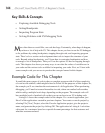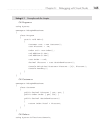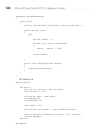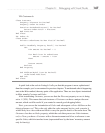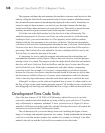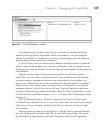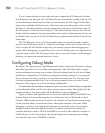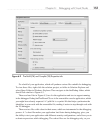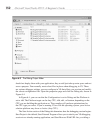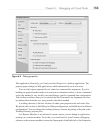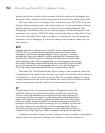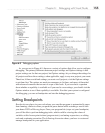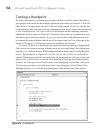
Chapter 6: Debugging with Visual Studio 149
From the perspective of reuse, many call sites to a method could indicate that the
method is relatively generic and reusable. While a low number of call sites might not
indicate the reusability of a method, zero call sites certainly indicates that the method is
not being used and can potentially be eliminated.
A lot of call sites could also indicate that a change to a method can have a significant
impact. Looking at the number of call sites that a method has could be informative from
the perspective of passing different values or seeing how many changes will be required in
called methods.
The previous discussion is to help you understand how call hierarchy might be
useful. Now, let’s look at how call hierarchy works. First, remember that call hierarchy
is context-sensitive, meaning that whatever code in the editor has focus defines your
point of view. The point of view for this example will be the GetOrderDiscount method
in the Customer class, and we want to see the call sites of GetOrderDiscount and what
statements inside of GetOrderDiscount are call sites. To use call hierarchy, either right-
click the GetOrderDiscount method in the editor and select View Call Hierarchy, or select
GetOrderDiscount in the editor and press
CTRL-K, T. VS shows the Call Hierarchy window
in Figure 6-1.
The Call Hierarchy window in Figure 6-1 shows Calls To and Calls From for the
GetOrderDiscount method. Calls To is a list of call sites to the GetOrderDiscount method.
Calls From is a list of statements within GetOrderDiscount that are call sites for other
class members.
The drop-down list at the top left of Figure 6-1, with My Solution selected, identifies
how far Call Hierarchy will look to find Calls To and Calls From call sites. The options
are My Solution, Current Project, and Current Document, which are self-explanatory.
Figure 6-1 The Call Hierarchy window






